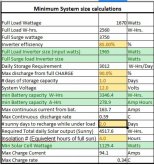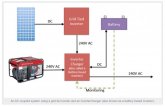My name is Robert, and I have a camp trailer arriving this month that I would like to outfit with a solar system that I would not have to rebuild anytime soon. I have watched several Will Prowse and Hobotech videos, and am thinking I want to do things a little different than most people do, but am seeking feedback if anything proposed her does not sound workable.
My trailer is an Intech Discover 7'x14' toy hauler, and I will have to replace the power center with one compatible with Lithium batteries. It currently is a 45A load center and I will be replacing it with a 75A Lithium charge converter model. The reason for the 75A model is because it can provide 1000W continuous from the battery bank.
I camp off forest service roads, so will not have shore power often, and will never use the included 11,000BTU roof AC. It's a low profile with side vents only, so I can cover it with solar panels and it can still operate if needed. I will use a small 5000BTU window style AC for hot weather boondocking.
What do I plan on running:
2- DC fridges
1- 1000W Blender for 3 minutes at a time
1- Audio system randomly
1- 27" DC TV for a couple hours at night randomly
1- Diesel Heater for 8 hours a night when cold
1- 5000BTU AC for an hour or so on hot nights to cool it off inside
I also have a Bluetti AC200 power station which has 1700Wh of battery and can handle 4800W surge to get the Blender and AC started, covering inrush requirements.
So what I was thinking is:
1) I can fit three 400W panels flat on the roof rack, connected to 3 of the four panel inputs to a 1200W 120VAC BT or WiFi micro inverter, also mounted on the roof rack for my solar panel system.
2) Feed the 120VAC from the micro inverter into a switch that selects micro inverter OR shore power input to the 75A load center.
3) 200Ah of 12V Lithium battery connected to the load center charge converter with a BT or WiFi shunt.
This would simplify the system into needing these items:
2- 100Ah LiFePo4 batteries
1- Shunt with wireless connectivity
1- 75A Lithium RV load center
3- 400W Mono panels
1- 1200W 120VAC Microinverter with wireless connectivity
1- 2 AC Source 30A input selector switch
So, what do you think?
Thanks for your feedback, Robert
My trailer is an Intech Discover 7'x14' toy hauler, and I will have to replace the power center with one compatible with Lithium batteries. It currently is a 45A load center and I will be replacing it with a 75A Lithium charge converter model. The reason for the 75A model is because it can provide 1000W continuous from the battery bank.
I camp off forest service roads, so will not have shore power often, and will never use the included 11,000BTU roof AC. It's a low profile with side vents only, so I can cover it with solar panels and it can still operate if needed. I will use a small 5000BTU window style AC for hot weather boondocking.
What do I plan on running:
2- DC fridges
1- 1000W Blender for 3 minutes at a time
1- Audio system randomly
1- 27" DC TV for a couple hours at night randomly
1- Diesel Heater for 8 hours a night when cold
1- 5000BTU AC for an hour or so on hot nights to cool it off inside
I also have a Bluetti AC200 power station which has 1700Wh of battery and can handle 4800W surge to get the Blender and AC started, covering inrush requirements.
So what I was thinking is:
1) I can fit three 400W panels flat on the roof rack, connected to 3 of the four panel inputs to a 1200W 120VAC BT or WiFi micro inverter, also mounted on the roof rack for my solar panel system.
2) Feed the 120VAC from the micro inverter into a switch that selects micro inverter OR shore power input to the 75A load center.
3) 200Ah of 12V Lithium battery connected to the load center charge converter with a BT or WiFi shunt.
This would simplify the system into needing these items:
2- 100Ah LiFePo4 batteries
1- Shunt with wireless connectivity
1- 75A Lithium RV load center
3- 400W Mono panels
1- 1200W 120VAC Microinverter with wireless connectivity
1- 2 AC Source 30A input selector switch
So, what do you think?
Thanks for your feedback, Robert





